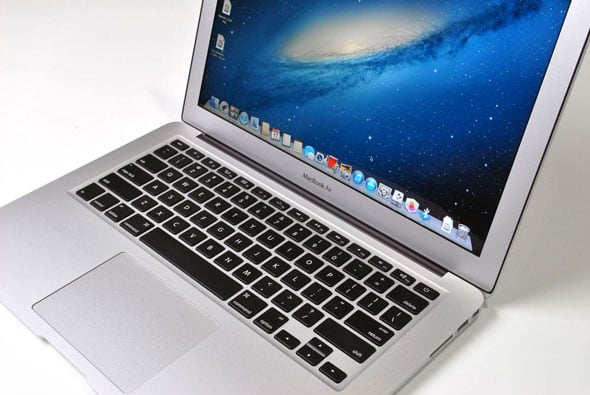Apple's Haswell-Powered 13-Inch MacBook Air
Introduction & Specifications
Intel's roll-out of their 4th generation Haswell-based Core series processors has been a little pokey, quite frankly, when you compare this launch to the deluge of products that hit the market when Ivy Bridge broke cover last year. Regardless, Apple always seems to have an inside track on Intel's latest technology and so, as it turns out, our first Haswell-powered notebook has finally arrived and it's none other than the Apple MacBook Air. The new MacBook Air for 2013 is virtually indistinguishable from the previous gen model, though if you'll look closely there actually two tiny pinholes on its left edge, for dual omnidirectional microphones, versus a single mic on previous models. Beyond that, it's the guts of the new Air that bring the glory.
In addition to the anticipated performance gains that Intel's new CPU might bring to the table for the MacBook Air, there are additional component-level enhancements that Apple baked in to their new ultra-light machine; namely a higher capacity 54 Whr battery and a PCI Express-based Solid State Drive (SSD). If you've been reading these pages for any length of time, you'll know the latter feature gets us more than a little fired-up. Let's see what the new MacBook Air is made of and if it holds its own versus Windows-based Ultrabook offerings in the market.

In addition to the anticipated performance gains that Intel's new CPU might bring to the table for the MacBook Air, there are additional component-level enhancements that Apple baked in to their new ultra-light machine; namely a higher capacity 54 Whr battery and a PCI Express-based Solid State Drive (SSD). If you've been reading these pages for any length of time, you'll know the latter feature gets us more than a little fired-up. Let's see what the new MacBook Air is made of and if it holds its own versus Windows-based Ultrabook offerings in the market.
|
- Mac OS X 10.8.4
- 1.3GHz dual-core Intel Core i5 (Turbo Boost up to 2.6GHz) with 3MB shared L3 cache
- 4GB of 1,600MHz DDR3L SDRAM
- 128GB or 256GB of PCI Express Flash storage
- Intel HD Graphics 5000
- 13.3-inch (diagonal) LED-backlit glossy widescreen, TN display
- 1440x900 native resolution (16:10)
- 802.11ac Wi-Fi (IEEE 802.11a/b/g/n compatible)
- Bluetooth 4.0
- Two USB 3.0 ports (up to 5Gbps)
- Thunderbolt port (up to 10Gbps)
- Mini DisplayPort video output (via Thunderbolt port)
- DVI output using Mini DisplayPort to DVI Adapter (sold separately)
- VGA output using Mini DisplayPort to VGA Adapter (sold separately)
- Dual-Link DVI output using Mini DisplayPort to Dual-Link DVI Adapter (sold separately)
- HDMI audio and video output using third-party Mini DisplayPort to HDMI Adapter (sold separately)
- MagSafe 2 power port
- SDXC card slot
- 720p FaceTime HD camera
- Built-in stereo speakers
- Dual internal omnidirectional microphones
- Headphone port
- Support for Apple iPhone headset with remote and microphone
- Full-size backlit keyboard with 78 (U.S.) or 79 (ISO) keys
- Multi-Touch trackpad with support for Multi-Touch gestures
- Built-in 54-watt-hour lithium-polymer battery
- 45W MagSafe Power Adapter with cable management system
- 0.11-0.68 x 12.8 x 8.94 inches (HxWxD) - 2.96 pounds

We won't belabor the point but Apple still hasn't seen fit to up the ante on the MacBook Air's display, opting instead to stick with the 1440x900 TN panel carried over from the previous generation 13-inch machine, with the 11-inch variant sporting a 1366x768 native res. Regardless, in its 13-inch incarnation, the MacBook Air's display is still a decent high-end option on the market, save perhaps for the Toshiba KIRAbook or the Chromebook Pixel -- both of which are significantly more expensive alternatives.
Again, notable upgrades come in the form of its storage subsystem and battery capacity with the new Air offering a 54Whr battery over last year's 50Whr cell. In fact, Apple claims "all-day battery life" with up to 12 hours of up-time in standard use and 10 hours with continuous movie playback. We'll have see if that pans out in testing but there's one more feature that stands out rather prominently and that's the MacBook Air's MSRP, which weighs in at a cool $100 less versus last year's 13-inch model (as tested). Let's look more at design and function, next.
Again, notable upgrades come in the form of its storage subsystem and battery capacity with the new Air offering a 54Whr battery over last year's 50Whr cell. In fact, Apple claims "all-day battery life" with up to 12 hours of up-time in standard use and 10 hours with continuous movie playback. We'll have see if that pans out in testing but there's one more feature that stands out rather prominently and that's the MacBook Air's MSRP, which weighs in at a cool $100 less versus last year's 13-inch model (as tested). Let's look more at design and function, next.







